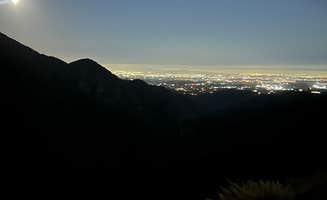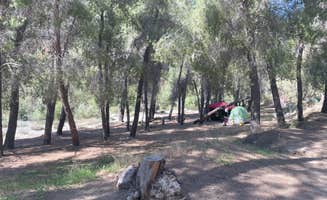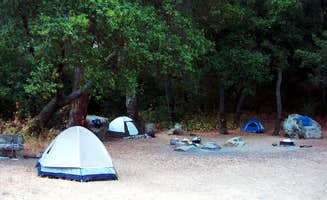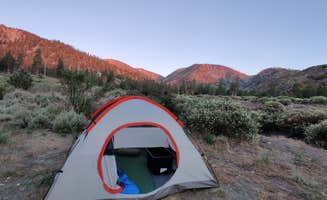Dispersed camping near Beverly Hills, California offers primitive sites within Angeles National Forest. These sites range from roadside pullouts to remote backcountry locations requiring hiking access. Winter temperatures in the higher elevations can drop below freezing, while summer brings extreme heat and elevated fire danger. Most dispersed camping areas require visitors to practice Leave No Trace principles and obtain appropriate permits.
What to do
Hiking opportunities: The Big Cone Camp area provides access to several water features. "This is a fairly easy hike through what would not be considered a typical hike. It starts off going through Thomas Aquinas College, winding through horse property and oil fields, before finally opening up into Santa Paula Canyon," notes one visitor. The area includes natural pools known locally as the "punch bowls" where hikers can cool off during warmer months.
Stargazing sessions: Angeles Crest areas offer night sky viewing despite proximity to Los Angeles. "Dark, fairly quiet, good view! I loved car camping here," reports one camper at Angeles Crest Overlook. Clear nights allow for astronomy opportunities, though weekend traffic can disrupt viewing. Weeknight visits typically provide more favorable stargazing conditions.
Off-road adventures: Several dispersed camping areas require four-wheel drive vehicles. "Trail was fun (definitely needed 4x4) and the sites around has good shade and good size open spots," reports a visitor to Stockton Flats. Forest roads provide technical driving challenges while accessing remote camping locations. Check forest service websites for current road conditions and closures before departing.
What campers like
Urban proximity: Many dispersed sites offer surprising seclusion despite being near Beverly Hills. "The view is gorgeous in the morning sunrise! That being said, it did seem like maybe a teen hangout or something - cars did flow in and out occasionally through the night until around midnight," reports one Angeles Crest visitor. This urban-adjacent camping provides quick escape options without extended travel time.
Peace during weekdays: Weekday camping typically offers quieter experiences than weekends. "During the week it's more quiet. Close to town so that is a plus," notes one camper. Most roadside pullouts experience reduced traffic Monday through Thursday, creating more favorable conditions for those seeking tranquility.
Dog-friendly options: Hare School Park provides options for vehicle campers with pets. "There's a dog park kind of area with a big field they can run around and just clean up after them," explains one visitor. This impromptu urban camping area offers convenience for travelers with animals, though lacks amenities and proper facilities.
What you should know
Seasonal restrictions: Fire regulations vary throughout the year. All dispersed camping areas enforce strict fire restrictions during high fire danger periods. "Camping outside established campgrounds within the Angeles National Forest is sometimes prohibited, you have to be on top of reading recently published orders," advises a visitor to Heaton Flats. Check current regulations at fs.usda.gov/angeles before planning trips.
Vehicle requirements: Many dispersed sites require appropriate vehicles. "Specs of this campground are wrong, no toilets/water/etc. Great for campers that meet 2 criteria 1) You have a Jeep, Truck or similar vehicle that can go off-road. 2) You enjoy dispersed camping," explains one camper about Stockton Flats. Standard passenger cars cannot access many forest roads, particularly after weather events.
Crowds fluctuate: Weekends bring increased activity to most sites. "Best to get there early as possible to secure a spot," advises one Stockton Flats visitor. Popular areas fill quickly on Friday afternoons, particularly during summer months and holidays. Parking areas along Angeles Crest Highway experience constant turnover during evenings and weekends.
Tips for camping with families
Safety considerations: Roadside camping presents unique challenges for families with children. "There were two others in our lot that stayed the night too. Cars did flow in and out occasionally through the night until around midnight," reports an Angeles Crest visitor. Select sites away from main roads when camping with children, and establish clear boundaries.
Trail difficulty assessment: When hiking to remote sites with children, evaluate trail conditions carefully. Stockton Flats Yellow Post Sites offers multiple camping options with varying access difficulty. "The turn is not marked well, in fact the coordinates are a little bit off. If you miss the turn like we did you have to go 5 miles or more to get a turnabout big enough," cautions one visitor. Research trail conditions through recent reviews before attempting with younger hikers.
Pack appropriately: No services exist at dispersed sites. "Perfect last minute late night hold over stop," mentions one Angeles Crest visitor, highlighting the site's minimal nature. Families must bring all necessary supplies including water, food, waste disposal bags, and emergency equipment. Cell service remains unreliable throughout most dispersed camping areas.
Tips from RVers
Size limitations: Large RVs face significant challenges accessing most dispersed sites. "We decided not to go to the site because it looked like a one lane road and too tight for our 35 ft bumper pull," reports one Stockton Flats visitor. Measure your vehicle length and clearance before attempting forest roads. Most roadside pullouts accommodate smaller campervans but lack space for larger rigs.
Parking location importance: Select stable, level surfaces for overnight parking. "I've been here for a couple days and nobody's mess with us. I'm in a 25 foot Fleetwood RV," reports one visitor to Hare School Park. Avoid soft ground during wet seasons which can lead to stuck vehicles. Position vehicles to maintain emergency exit routes and avoid blocking forest roads.





